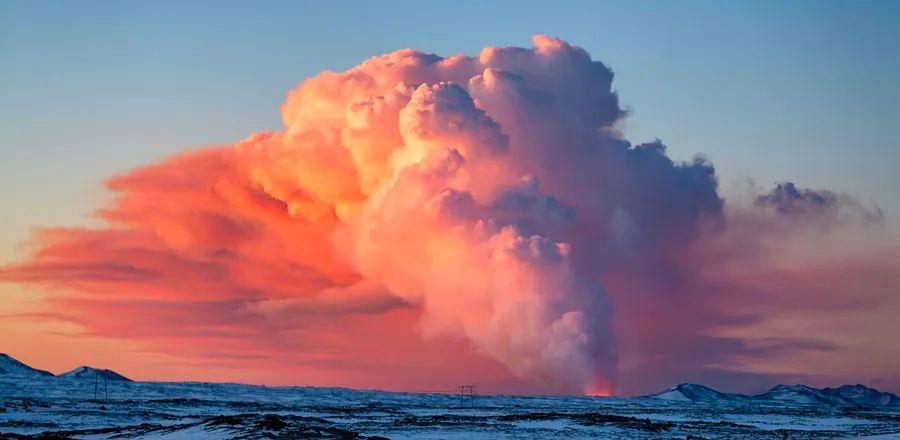Iceland's Volcano Erupts for the Third Time, Leading to Evacuations and Temporary Closure of the Blue Lagoon

For the third occasion since December, a volcano erupted on Iceland’s Reykjanes peninsula, causing evacuations and leaving thousands without heat and hot water. Additionally, the Blue Lagoon, one of Iceland’s premier tourist attractions, has temporarily closed. While the popular geothermal spa was unharmed, a key road to the lagoon and its nearby hotels and restaurants was blocked by lava.
The Blue Lagoon has evacuated its facilities and will stay closed until at least Tuesday, February 13, as a safety precaution, according to a statement from the company’s website. The statement added: “We will continue to closely adhere to the guidelines and recommendations from the authorities, collaborating with them to monitor the situation. This commitment reflects our steadfast dedication to ensuring the safety and well-being of our valued guests and staff.”
The eruption began at approximately 6 a.m. local time on Thursday, February 8, following around 30 minutes of “intense seismic activity” in the area northeast of Mount Sýlingarfell, according to the Iceland Met Office (IMO), the national weather service of the country.
A fissure nearly two miles wide opened up, launching fountains of lava as high as 250 feet into the air, accompanied by a volcanic plume (a column of volcanic particles and gases) that soared nearly two miles high. Within the first seven hours of the eruption, the volcano released an estimated 15 million cubic meters of lava.
Located in southwest Iceland, the Reykjanes peninsula is one of the nation’s most populated regions, housing around 30,000 residents in a country with a total population of about 375,000. Lava has damaged a pipeline linking the Svartsengi geothermal power plant to nearby towns and Keflavík Airport, leaving approximately 20,000 people without hot water and heating while winter temperatures have hovered around a frigid 21 degrees Fahrenheit.

Courtesy of Chris Lawton/Unsplash
While efforts are underway to repair the pipeline, Iceland’s Department of Civil Protection and Emergency Management has declared a state of emergency, leading to the temporary closure of schools, museums, and other public institutions on Friday.
Just a few miles from the Blue Lagoon, the fishing town of Grindavík, home to about 3,800 residents, has remained deserted since its evacuation in November. The eruption in January caused fissures in the roads around the town, and some homes were destroyed by the flowing lava.
Keflavík Airport, the largest international airport in Iceland situated on the Reykjanes peninsula, remains operational for the time being. The recent eruptions have not affected air travel, in contrast to the Eyjafjallajökull volcano eruption in 2010, which released ash and smoke, disrupting flights for over a week.
The U.S. Embassy in Reykjavík has issued a new volcano alert, advising in a statement from February 8 that “U.S. citizens should monitor local news and government websites for updates and adhere to Iceland Civil Protection instructions.”
As of Friday, seismic activity had lessened, although the eruption continues to influence the area.
By Friday afternoon, volcanic activity was still declining, with the IMO reporting “no signs of eruptive activity.” However, the duration of this calm period remains uncertain. Prior to the eruption in 2021, which took place in the Geldingadalir valley—part of the Fagradalsfjall fissure system approximately 10 miles east of the current activity—the last eruption on the Reykjanes peninsula occurred in 1240 C.E.
“The return to activity on the peninsula after 781 years of dormancy is quite typical based on geological observations, and it’s expected that we will see frequent eruptions in the area for many years—potentially centuries—going forward,” explains Loÿc Vanderkluysen, a volcanologist and associate professor of biodiversity, earth, and environmental science at Drexel University in Philadelphia. He notes that the previous active phase lasted about 400 years, from around 800 to 1240 C.E.
In light of the possibility of years or even centuries of volcanic activity on the peninsula, following the eruption in November, Icelandic authorities initiated the construction of protective barriers reaching up to three stories around the Svartsengi power plant to help redirect lava flows from future eruptions. They also started erecting barriers around Grindavík, although these ultimately failed to prevent the lava from consuming several homes.
“Grindavík could potentially be reinhabited or rebuilt if volcanic activity shifts to fissure systems further east, but I believe it’s likely that the town will continue to face threats for years or decades,” says Vanderkluysen.
Fortunately, Keflavík Airport is positioned far enough north, “away from the fissure systems, which should keep it safe during this surge on the Reykjanes peninsula,” he notes. However, he warns that “Frequent eruptions might lead to temporary airport closures due to volcanic particles in the air, which can be detrimental to aircraft engines.”

1

2

3

4

5
Evaluation :
5/5